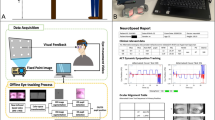Abstract
Purpose
Evaluating the passive duction force of the extraocular muscles is important for the diagnosis of and surgical planning for strabismus. This is especially relevant in patients with an observable limitation of duction movement. The purpose of this study was to validate passive duction forces in healthy subjects using a novel instrument.
Methods
An instrument for making continuous quantitative measurements of passive duction forces was designed. Tension was measured as the eyeball was rotated horizontally or vertically from the resting position under general anesthesia 10 mm (50°) away from the direction of force to be tested (opposite side).
Results
Seventy eyes of 35 subjects were enrolled in this study (age range of 4–80 years and mean age of 36.3 years). The passive duction force was measured at 49.0 ± 15.3 g (mean ± standard deviation) for medial rotation, 44.8 ± 13.2 g for lateral rotation, 50.5 ± 14.8 g for superior rotation, and 53.5 ± 13.8 g for inferior rotation. The passive duction forces were similar for all gaze positions, but it was larger for inferior rotation than for lateral rotation (P = 0.009). The passive duction force was significantly larger for vertical rotation (51.9 ± 14.4 g) than for horizontal rotation (46.9 ± 14.4 g) (P = 0.006). The passive duction force did not differ significantly with sex (P = 0.355), side (P = 0.087), or age (P = 0.872).
Conclusions
These measurements of passive duction forces in a healthy population provide valuable information for diagnosing specific strabismic problems and could be useful for increasing the precision of strabismus surgery.

Graphical abstract






Similar content being viewed by others
Data availability
Raw data table
References
Metz HS, Cohen GH (1984) Quantitative forced duction measurement. Am Orthop J 34:28–38
Kushner BJ, Vrabec M (1987) Theoretical effects of surgery on length tension relationships in extraocular muscles. J Pediatr Ophthalmol Strabismus 24:126–131
Vishwanath M, Ansons A (2009) Midoperative forced duction test as a guide to titrate the surgery for consecutive exotropia. Strabismus. 17:41–44
Kim S, Yang HK, Hwang JM (2018) Surgical outcomes of unilateral recession and resection in intermittent exotropia according to forced duction test results. PLoS One 13:e0200741
Jung JH, Holmes JM (2015) Quantitative intraoperative torsional forced duction test. Ophthalmology. 122:1932–1938
Metz HS (1976) Forced duction, active force generation, and saccadic velocity tests. Int Ophthalmol Clin 16:47–73
Scott AB, Collins CC, O’Meara DM (1972) A forceps to measure strabismus forces. Arch Ophthalmol 88:330–333
Collins CC, O’Meara D, Scott AB (1975) Muscle tension during unrestrained human eye movements. J Physiol 245:351–369
Collins CC, Carlson MR, Scott AB, Jampolsky A (1981) Extraocular muscle forces in normal human subjects. Invest Ophthalmol Vis Sci 20:652–664
Lennerstrand G, Schiavi C, Tian S, Benassi M, Campos EC (2006) Isometric force measured in human horizontal eye muscles attached to or detached from the globe. Graefes Arch Clin Exp Ophthalmol 244:539–544
Rosenbaum AL, Myer JH (1980) New instrument for the quantitative determination of passive forced traction. Ophthalmology. 87:158–163
Bekerman I, Gottlieb P, Vaiman M (2014) Variations in eyeball diameters of the healthy adults. J Ophthalmol 2014:503645
Lim HW, Lee DE, Lee JW, Kang MH, Seong M, Cho HY, Oh JE, Oh SY (2014) Clinical measurement of the angle of ocular movements in the nine cardinal positions of gaze. Ophthalmology. 121:870–876
Stephens KF, Reinecke RD (1967) Quantitative forced duction. Trans Am Acad Ophthalmol Otolaryngo 71:324–329
Schillinger RJ (1966) The prevention of over-correction and under-correction in horizontal strabismus surgery. J Pediatr Ophthalmol Strabismus 3:38–41
Scott AB (1971) Extraocular muscle forces in strabismus. In: Bach-Y-Rita P, Collins CC, Hyde JE (eds) The Control of Eye Movements. Academic Press, New York, pp 327–342
Gao Z, Guo H, Chen W (2014) Initial tension of the human extraocular muscles in the primary eye position. J Theor Biol 353:78–83
Hertle RW, Granet DB, Zylan S (1993) The intraoperative oculocardiac reflex as a predictor of postoperative vaso-vagal responses during adjustable suture surgery. J Pediatr Ophthalmol Strabismus 30:306–311
Sainsbury P, Gibson JB (1954) Symptoms of anxiety and tension and the accompanying physiological changes in the muscle system. J Neurol Neurosurg Psychiatry 17:216–224
Rosenbaum AL, Santiago AP (1999) Clinical strabismus management: principles and surgical techniques. Saunders, Philadelphia, pp 39–41
Kallestad KM, Hebert SL, McDonald AA, Daniel ML, Cu SR, McLoon LK (2011) Sparing of extraocular muscle in aging and muscular dystrophies: a myogenic precursor cell hypothesis. Exp Cell Res 317:873–885
Funding
This work was supported by the Konkuk University Medical Center Research Grant 2017 (No. 201711). This sponsor had no role in the design or conduct of this research.
Author information
Authors and Affiliations
Contributions
HK Kang developed instrument and analyzed the data. SH Lee designed the study and illustrated figures. HJ Shin designed the study, collected the data and wrote the manuscript. AG Lee revised the manuscript.
Corresponding author
Ethics declarations
Conflict of interest
The authors declare that they have no conflict of interest.
Code availability
Not applicable
Ethics approval
All procedures performed in studies involving human participants were in accordance with the ethical standards of the institutional and/or national research committee and with the 1964 Helsinki declaration and its later amendments or comparable ethical standards. The study protocol was approved by the Institutional Review Board (IRB) of Konkuk University Medical Center (registration number: KUH1100071).
Consent to participate
Informed consent was obtained from all individual participants included in the study.
Additional information
Publisher’s note
Springer Nature remains neutral with regard to jurisdictional claims in published maps and institutional affiliations.
Electronic supplementary material
ESM 1
(DOCX 25 kb)
Rights and permissions
About this article
Cite this article
Kang, H., Lee, SH., Shin, H.J. et al. New instrument for quantitative measurements of passive duction forces and its clinical implications. Graefes Arch Clin Exp Ophthalmol 258, 2841–2848 (2020). https://doi.org/10.1007/s00417-020-04848-9
Received:
Revised:
Accepted:
Published:
Issue Date:
DOI: https://doi.org/10.1007/s00417-020-04848-9




